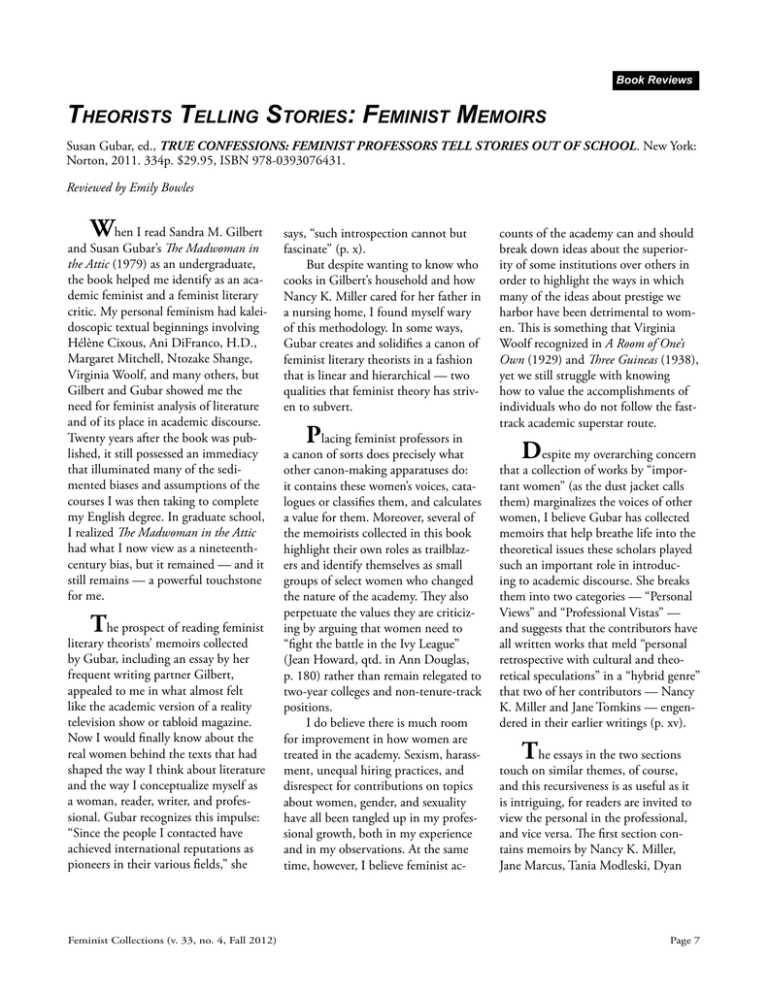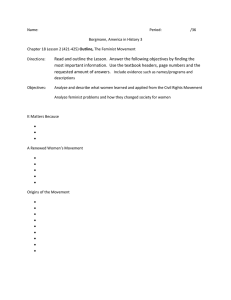
Book Reviews
Theorists Telling Stories: Feminist Memoirs
Susan Gubar, ed., TRUE CONFESSIONS: FEMINIST PROFESSORS TELL STORIES OUT OF SCHOOL. New York:
Norton, 2011. 334p. $29.95, ISBN 978-0393076431.
Reviewed by Emily Bowles
W
hen I read Sandra M. Gilbert
and Susan Gubar’s The Madwoman in
the Attic (1979) as an undergraduate,
the book helped me identify as an academic feminist and a feminist literary
critic. My personal feminism had kaleidoscopic textual beginnings involving
Hélène Cixous, Ani DiFranco, H.D.,
Margaret Mitchell, Ntozake Shange,
Virginia Woolf, and many others, but
Gilbert and Gubar showed me the
need for feminist analysis of literature
and of its place in academic discourse.
Twenty years after the book was published, it still possessed an immediacy
that illuminated many of the sedimented biases and assumptions of the
courses I was then taking to complete
my English degree. In graduate school,
I realized The Madwoman in the Attic
had what I now view as a nineteenthcentury bias, but it remained — and it
still remains — a powerful touchstone
for me.
The prospect of reading feminist
literary theorists’ memoirs collected
by Gubar, including an essay by her
frequent writing partner Gilbert,
appealed to me in what almost felt
like the academic version of a reality
television show or tabloid magazine.
Now I would finally know about the
real women behind the texts that had
shaped the way I think about literature
and the way I conceptualize myself as
a woman, reader, writer, and professional. Gubar recognizes this impulse:
“Since the people I contacted have
achieved international reputations as
pioneers in their various fields,” she
Feminist Collections (v. 33, no. 4, Fall 2012)
says, “such introspection cannot but
fascinate” (p. x).
But despite wanting to know who
cooks in Gilbert’s household and how
Nancy K. Miller cared for her father in
a nursing home, I found myself wary
of this methodology. In some ways,
Gubar creates and solidifies a canon of
feminist literary theorists in a fashion
that is linear and hierarchical — two
qualities that feminist theory has striven to subvert.
P
lacing feminist professors in
a canon of sorts does precisely what
other canon-making apparatuses do:
it contains these women’s voices, catalogues or classifies them, and calculates
a value for them. Moreover, several of
the memoirists collected in this book
highlight their own roles as trailblazers and identify themselves as small
groups of select women who changed
the nature of the academy. They also
perpetuate the values they are criticizing by arguing that women need to
“fight the battle in the Ivy League”
(Jean Howard, qtd. in Ann Douglas,
p. 180) rather than remain relegated to
two-year colleges and non-tenure-track
positions.
I do believe there is much room
for improvement in how women are
treated in the academy. Sexism, harassment, unequal hiring practices, and
disrespect for contributions on topics
about women, gender, and sexuality
have all been tangled up in my professional growth, both in my experience
and in my observations. At the same
time, however, I believe feminist ac-
counts of the academy can and should
break down ideas about the superiority of some institutions over others in
order to highlight the ways in which
many of the ideas about prestige we
harbor have been detrimental to women. This is something that Virginia
Woolf recognized in A Room of One’s
Own (1929) and Three Guineas (1938),
yet we still struggle with knowing
how to value the accomplishments of
individuals who do not follow the fasttrack academic superstar route.
D
espite my overarching concern
that a collection of works by “important women” (as the dust jacket calls
them) marginalizes the voices of other
women, I believe Gubar has collected
memoirs that help breathe life into the
theoretical issues these scholars played
such an important role in introducing to academic discourse. She breaks
them into two categories — “Personal
Views” and “Professional Vistas” —
and suggests that the contributors have
all written works that meld “personal
retrospective with cultural and theoretical speculations” in a “hybrid genre”
that two of her contributors — Nancy
K. Miller and Jane Tomkins — engendered in their earlier writings (p. xv).
T
he essays in the two sections
touch on similar themes, of course,
and this recursiveness is as useful as it
is intriguing, for readers are invited to
view the personal in the professional,
and vice versa. The first section contains memoirs by Nancy K. Miller,
Jane Marcus, Tania Modleski, Dyan
Page 7
Book Reviews
Elliott, Shirley Geok-lin Lim, Patricia
Yaeger, Jane Tompkins, Rayna Rapp,
Sandra M. Gilbert, Leila Ahmed, Gayatri Chakravorty Spivak, Hazel Carby,
Neferti Tadiar, and Ann DuCille.
Among these, I found Yaeger’s rivetingly personal, in part because she shows
a tremendous amount of intrepidity in
writing about a topic that has not been
entirely transformed from a shameful,
pathologized, embodied experience
into theory. Yaeger states in the first
paragraph that “bulimia was
my path to feminism” (p. 51),
a statement that is searing in
its directness. She goes on to
discuss the “spatial indelicacy
of skin” in ways that oscillate between the personal and
theoretical in a beautiful manner that highlights how much
feminist theory is born of its
authors’ bodies, while it is also
what creates these bodies and
(in Yaeger’s case, as in my own)
saves them from the denigration that our culture so often
perpetuates.
that is always also bound up in a desire to write and rewrite the personal
so that key stories are told — and so
that she, as a feminist and a theorist,
can learn over and over again from her
foremothers.
T
he second part of the collection
comprises essays by Martha C. Nussbaum, Ann Douglas, Lillian Faderman,
Jane Gallop, Annette Kolodny, Frances
Smith Foster, Hortense J. Spillers, Tey
J
S
pivak’s essay also offers a remarkably powerful
analysis of the slippages and
gaps between the personal and
the theoretical. She explains,
“My modest reputation rests
on two items: my introduction to Derrida, and my commentary on Bhubaneshwari
Bjaduri’s suicide. I am following that track still. Why did I
not mention my relationship
to her when I wrote of her? I
wanted to see what would happen if I
didn’t have that certificate of authenticity which would reflect more on the
people’s approval of her than on me”
(p. 120). Spivak thus acknowledges a
need for detachment from the personal
Page 8
professional stakes are high and they
spotlight trends that should continue
to enrage us. Kolodny’s essay describes
how women placed in a context of
academic hierarchy turned against one
another to ensure their own survival
in that male-dominated hierarchical
framework. I found very powerful her
description of the regret she felt that
four young female faculty could not
find support in each other, and I wondered as I read some of the other memoirs about how much progress
we have made, for several
of the essays focus on how
women need to penetrate Ivy
League colleges so that they
can achieve success in the hierarchical terms that, again, so
often break down relationships
between women in a way that
values the structure of institutions over more personal intellectual or academic pursuits.
Diana Rebolledo, Nancy J. Chodorow,
Rosemary Radford Ruether, Linda Nochlin, Susan McClary, and Jill Dolan.
Some of these memoirs are excruciating, courageous, and at times frustrating, for they reveal how detrimental
women can be toward each other when
ane Gallop’s analysis of
herself as a “feminist professor who was accused by two
students of sexual harassment”
(p. 190) provides a fascinating glimpse of the problems
that emerge when the terms
of feminism and our cultural
expressions of it change. She
identifies feminism as an intellectual category that is inextricably linked to the sexual,
and she juxtaposes the almostutopian feminism of the
1970s against 1990s academic
culture, in which “charges of
sexual harassment mingled
freely with other complaints about
manifestations of power” (p. 199).
Gallop then provides a very significant
assessment of how we need to embrace
“a gender-neutral formulation of sexual
harassment” that does not punish a
Feminist Collections (v. 33, no. 4, Fall 2012)
Book Reviews
woman simply (or, perhaps, not so
simply) because “she is both sexual and
powerful” (p. 202).
Susan McClary’s description of
the unlikely trajectory she followed
in becoming a “recognized feminist”
(p. 310) is perhaps a unifying thread
in these essays. Frances Smith Foster
describes being asked whether she
really belonged in “Black Studies or
Women’s Studies” (p. 222); Martha
C. Nussbaum says she can look back
and see that she lived as a “prisoner of
politeness” (p. 171); and Tey Diana
Rebolledo recognizes that although
“the feminist movement made [her]
rethink [her] life,” she had to struggle
for many years to gain “credibility as a
scholar in Chicano/a studies” (p. 249).
Each of these women, like the other
feminist professors Gubar has brought
together in True Confessions, views
feminism as both a defining framework
for her scholarship and as a sometimes
amorphous discourse that can, if not
adapted to meet the needs of our intersectional identities, exclude and disempower us as well.
By bringing together the voices of
so many influential feminist professors,
Gubar has shown the complexity of the
role that feminism plays in the acad-
emy. Like The Madwoman in the Attic
and other canon-making feminist texts
from the 1970s, True Confessions charts
new territory that we can begin to explore and renegotiate according to our
own experiences of the personal and
professional landscape we inhabit.
[Emily Bowles is a senior lecturer in English and women’s studies at the University
of Wisconsin–Fox Valley, as well as the
assistant to the chairs for the UW Colleges. Her professional interests include
eighteenth-century women’s writing and
representations of anomalies of gender
and sexuality in eighteenth-century texts.]
Miriam Greenwald
Feminist Collections (v. 33, no. 4, Fall 2012)
Page 9







